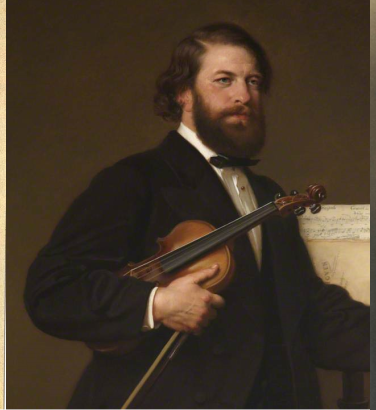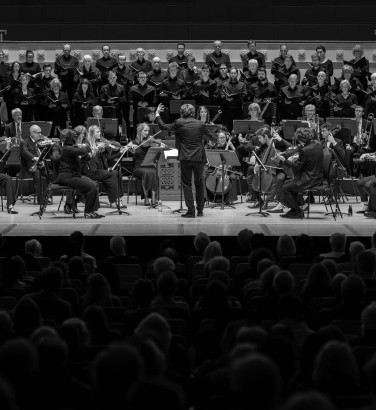
The clarinet concerto
11 Nov 2024
News Story
SCO Principal Clarinet Maximiliano Martín (credit: Christopher Bowen 2024)
This article is part of an ongoing series this Season focusing on the concerto as written for specific instruments in the orchestra. With contributions from SCO players, we hope these give you some new insight into works you know and an idea of others they would recommend seeking out.
The chamber orchestra is so well-established as an ensemble that it can be a little disconcerting to realise that the clarinet was the last instrument to join its ranks, all the way back in the 1780s – no mean achievement considering that it was very much a newcomer. It remains the only member of the chamber orchestra whose sound is produced via a single reed; the only others to use reeds (the oboe and bassoon) are played by blowing through a pair of them, tied together.
The clarinet has a clear ancestor in the chalumeau, an instrument whose heyday came in the early 1700s – inasmuch as it had one: it barely figures in music by Handel, and Bach appears to have overlooked it entirely. The best-known composers to have explored the potential of the chalumeau in the Baroque era are Vivaldi and Telemann, and even they only wrote a handful of works for it. The true clarinet came about as a result of technological improvements to this instrument, and proved so much more agile (not least in the extent of its range) that the chalumeau was quickly eclipsed.
Mozart is generally believed to be the composer to have spearheaded the growing popularity of the clarinet, but it had already begun by 1750, six years before his birth. By the time he probably first encountered it (aged 8, while visiting London), the instrument had been heard in many European capitals, and as far afield as St Petersburg and Pennsylvania. It is undeniable, however, that Mozart was the first major composer truly to fall for its sound, his friendship with the virtuoso Anton Stadler resulting in a plethora of fine clarinet music, both within ensembles and as a solo instrument. Chief among these is his Clarinet Concerto, a work both the SCO's clarinettists – Principal Maximiliano Martín (Maxi) and Sub-Principal William Stafford – are quick to acknowledge as a cornerstone of their repertoire: it stands among the concertos Maxi has “always enjoyed the most”, while William deems it (along with the Clarinet Quintet) “sublimely beautiful”. From an audience perspective, it is very difficult to disagree.
If there’s a flipside to this, it’s in Mozart’s concerto being so popular (however deservedly so) that many other composers’ contributions to the genre have been all but forgotten - among them Krommer's Concerto for two clarinets, which Maxi and William perform in our Eine kleine Nachtmusik concerts (11-13 December). Weber’s three concertante works for clarinet – two concertos and a concertino, all dating from the 1810s – are still played occasionally, but Spohr’s four concertos (composed between 1808 and 1829) should, in Maxi’s words, “be played much more than they really are”. Their significance extends far beyond being attractive pieces of music, as Spohr was the unintentional catalyst in another leap forwards in the instrument’s design. The solo part he had written in his first concerto was so difficult that its dedicatee Johann Simon Hermstedt (who was clearly very taken with the work) actually had to adapt his instrument to make it playable. Maxi is under no illusions about the challenges Spohr's concertos present the clarinettist to this day: “the writing is fantastic,” he says, but “they are hard”!
There is a slight tapering off in the number of concertos written for clarinet in the 19th century, but its position as an orchestral instrument was secure. Beethoven had basked in the warmth of its sound from his earliest days – he seems to relish it in slow movements, for instance in the Second and Fourth Symphonies or the First Piano Concerto – and many later composers would follow suit. Berlioz went further, writing in his Grand Treatise on Modern Instrumentation and Orchestration of the clarinet’s “invaluable ability to render distant sounds, an echo, the reverberation of an echo or the charm of the twilight”.

SCO Sub-Principal Clarinet William Stafford
Credit: Christopher Bowen 2024William – as befits his position as Sub-Principal – especially values those works in which both clarinets have a moment in the spotlight, for instance in the “lovely duet” towards the end of Mendelssohn’s Hebrides Overture, which provides an oasis of calm before the stormy music resumes one final time. Later in the 19th century and moving forwards into the 20th, Maxi identifies a spate of "wonderful solos" in works from musical cultures beyond western Europe, for instance in Rimsky-Korsakov’s Sheherazade , Bartók's The Miraculous Mandarin, Kodály's Dances of Galánta and (looking to the opposite side of the globe) Ginastera's Variaciones Concertantes.
The basset horn (a distant relative) had long since fallen from favour by this point - it had perhaps had its finest hour in Mozart's final year, Maxi appreciating solo spots in La clemenza di Tito while William prefers the Requiem - but a little clarinet family had formed in the meantime. Berlioz, ever the innovator, had found room for the high E flat clarinet in Symphonie fantastique all the way back in 1830: its rendition of the idée fixe at the heart of the work transforms what had been yearning sentiment into grotesque mockery in a witches' sabbath. (This is understandably another favourite of William's.) At the other end of the scale, the bass clarinet does not get many solos, but its tones can communicate warmth (for example in the Dance of the Sugar Plum Fairy from Tchaikovsky’s Nutcracker) or contribute to a prevailing sense of darkness (as in Rachmaninov’s Isle of the Dead) with equal ease.
In the midst of all this innovation, the standard clarinet made further headway in the realm of chamber music, with much of its finest repertoire emerging during the course of the 19th century. It is an integral part of Schubert's Octet and would have more of a solo role in Brahms' Quintet and two Sonatas, paving the way for a good deal of French chamber music in the new century. For Maxi, Debussy's Première Rhapsodie and Messiaen's Quartet for the End of Time are particular standouts, though it's also worth mentioning the three sonatas by Poulenc: one with piano, another with bassoon and the final one for a pair of clarinets.
The instrument also found a warm welcome on the other side of the Atlantic. Elliott Carter wrote a surprising amount of music for clarinet during his long lifespan (he died in 2012, aged 103), including a Concerto and Quintet, but perhaps more significantly, it had found yet another home in jazz earlier in the century. One of the clarinettist's best-known (and nerve-inducing) solos had emerged back in the Roaring Twenties: the deliciously slinky glissando which introduces Gershwin’s Rhapsody in Blue. Benny Goodman, one of the country's foremost jazz musicians, would go on to commission Copland's Clarinet Concerto, ranked by Maxi among the true greats. Among more recent works, our Principal Clarinet also enjoys Adams' Gnarly Buttons and, closer to home, MacMillan's Clarinet Quintet.
Given the richness of the repertoire available - and bearing in mind that anything pre-Baroque would be wishful thinking - what gaps does this leave, particularly in terms of concertos? Maxi suggests that Beethoven, Chopin and Poulenc could all have made significant contributions to the genre, but there is one (perhaps surprising) composer whose hypothetical concerto would, in his opinion, outrank these. "I think the clarinet is a very operatic instrument," he says, "so it could have been amazing" to have a concerto by Puccini.
Related Stories
![A violinist shown at three different ages: as a young man in a drawing, middle-aged in a painting and elderly in an old photo]()
Joseph Joachim and the great German violin concertos
7 April 2025
Beethoven, Mendelssohn, Bruch and Brahms: four violin concertos, all connected by a single violinist.![Three men, the first two in 18th century formal dress (one in black and white, one in a red coat), the last in an old photo, smoking]()
What is a sinfonia concertante?
17 March 2025
We delve into the history of a hybrid genre ...![]()
The SCO Chorus on music for Lent
10 March 2025
With Easter just around the corner, we delve into perhaps the richest (and often darkest) choral repertoire of all ...


